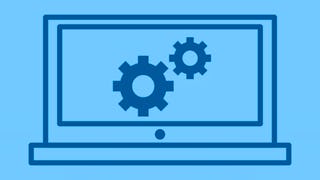This course will cover the fundamental concepts and philosophy behind free and open source software (FOSS). The course will discuss open source and free software licensing; open source business strategies and impact; FOSS utilization in the enterprise; and development methodologies. Students will learn to set up and configure an industry-standard open source operating system, including system installation, and basic system administration; system architecture; package management; command–line commands; devices, filesystems, and the filesystem hierarchy standard. Also addressed are applications, shells, scripting and data management; user interfaces and desktops; administrative tasks; essential system services; networking fundamentals; and security, as well as support issues for open source software. Multiple distributions are covered with emphasis on the two leading enterprise distribution families.



Kompetenzen, die Sie erwerben
- Kategorie: IT Automation
- Kategorie: Unix Commands
- Kategorie: Package and Software Management
- Kategorie: Linux Commands
- Kategorie: System Configuration
- Kategorie: File Systems
- Kategorie: Open Source Technology
- Kategorie: Virtual Machines
- Kategorie: Linux
- Kategorie: Command-Line Interface
- Kategorie: Operating Systems
- Kategorie: Systems Administration
- Kategorie: Firewall
- Kategorie: General Networking
- Kategorie: Virtualization
- Kategorie: Web Servers
- Kategorie: Shell Script
- Kategorie: Linux Administration
- Kategorie: Software Installation
- Kategorie: Red Hat Enterprise Linux
Wichtige Details

Zu Ihrem LinkedIn-Profil hinzufügen
Erfahren Sie, wie Mitarbeiter führender Unternehmen gefragte Kompetenzen erwerben.

In diesem Kurs gibt es 9 Module
Welcome to Introduction to Open Source Operating Systems! Module 1 offers a deep dive into the rich technological and philosophical history of the Unix operating system, covering two pivotal periods: from its inception in 1969 to 1984, and from 1984 to 2015. Students will explore the groundbreaking developments and the ethos that shaped Unix during its formative years and how it has continued to influence modern computing paradigms. Emphasis is placed on recognizing the seminal contributions of Unix's key architects and contributors, providing a comprehensive understanding of the system's enduring legacy in today's technological landscape.
Das ist alles enthalten
15 Videos7 Lektüren4 Aufgaben1 Diskussionsthema
This module provides a comprehensive exploration of the Linux ecosystem, beginning with the function and features of package managers and App stores, which streamline software installation and management. Students will understand the roles of window managers and desktop environments in shaping user interaction, as well as the intricacies of display protocols like X and Wayland. The course demystifies the various types of desktop Linux, delves into the practicalities of compiling source code, and explains the concept and diversity of Linux distributions. Comparing the major distribution families, the module also equips students with the skills to utilize virtualization platforms for deploying different distros, offering a holistic view of Linux's framework and its applications.
Das ist alles enthalten
23 Videos6 Lektüren4 Aufgaben
Module 3 turns the spotlight on the powerful capabilities of the Linux command line, providing learners with the expertise to leverage the grep command for intricate search operations and replacements using shell meta-characters. Students will delve into techniques for locating files and directories within the filesystem, and grasp the essentials of input/output redirection and piping, including the nuances of standard input, output, and error. Key concepts such as file permissions, security nomenclature, and the significance of shell meta-characters in expanding shell functionalities will be explained. The course also covers the fundamentals of traversing the filesystem with shell commands, the role of the Linux Shell within the OS, and the use of absolute and relative paths, all while demystifying the structure of the Linux Filesystem for efficient system navigation and management.
Das ist alles enthalten
16 Videos6 Lektüren4 Aufgaben
Module 4 empowers students with the skills to automate routine tasks in Linux using the cron scheduling service and to craft effective shell scripts incorporating positional parameters. Students will learn to declare and understand the scope of system environment variables, and to construct conditional statements within Bash scripts for logical flow control. The course also explains the manipulation of the system PATH, modifications to user profiles, and the automation of tasks through shell scripting. Additionally, students will become familiar with the capabilities of the vi(m) editor, and distinguish between stream editors and text editors, laying a solid foundation for advanced text processing and system administration in a Linux environment.
Das ist alles enthalten
12 Videos5 Lektüren4 Aufgaben
Module 5 provides a deep understanding of Linux system administration, starting with the sudo command's crucial role in maintaining root user security. Students will learn the processes for creating and managing user accounts, as well as the significance and analysis of system logs for maintaining system health and security. The coursework introduces essential system tools for ongoing monitoring and reporting, and presents the "3Ps" (Problem, Procedure, and Prevention) troubleshooting methodology. Additionally, the module covers secure remote access techniques, ensuring students can administer Linux systems effectively while upholding stringent security standards.
Das ist alles enthalten
15 Videos6 Lektüren4 Aufgaben
This module focuses on the Linux boot process by breaking it down into its three fundamental phases, providing a clear explanation of what occurs during each stage. Students will compare the traditional SysVinit system with the newer systemd init system, gaining insight into their differences, functionalities, and service management techniques. Focusing on system tools for process examination, this module clarifies the purposes of Linux targets and service levels. It also delves into the structure and management of filesystems, including a comparison of different Linux filesystems, the mechanics of virtual disk creation and attachment, and the fundamentals of Logical Volume Management. Additionally, the course covers efficient command-line tools for compression, archiving, disk utilization, and mounting, equipping students with practical skills for comprehensive system management.
Das ist alles enthalten
28 Videos5 Lektüren4 Aufgaben
This module equips students with the essential knowledge to configure, manage, and troubleshoot basic network settings on Linux operating systems. It introduces fundamental network diagnostic tools to maintain connectivity and system integrity. The course also provides in-depth training on configuring and deploying major webserver platforms, allowing students to compare and discuss the applications of leading open-source webservers within the industry, with a focus on securing webserver configurations. Students will learn to install and configure popular SQL and NoSQL databases, gaining practical database management skills. And lastly, this module covers the selection and configuration of desktop-based firewalls, ensuring students can secure Linux systems effectively against network threats.
Das ist alles enthalten
20 Videos5 Lektüren4 Aufgaben
This module addresses the critical role of automation in Linux systems, outlining the challenges it solves by streamlining and simplifying complex tasks. Students will be introduced to the current landscape of orchestration and automation tools, with a particular focus on the contributions of Hashicorp to the field. They will learn the processes for automating the installation of Linux operating systems and discover solutions for deploying complete applications using automation tools. Additionally, the course delves into the concept of secrets management within automated environments, teaching students how to securely handle sensitive information in an automated and scalable manner.
Das ist alles enthalten
23 Videos5 Lektüren4 Aufgaben
This module contains the summative course assessment that has been designed to evaluate your understanding of the course material and assess your ability to apply the knowledge you have acquired throughout the course. Be sure to review the course material thoroughly before taking the assessment.
Das ist alles enthalten
1 Aufgabe
Erwerben Sie ein Karrierezertifikat.
Fügen Sie dieses Zeugnis Ihrem LinkedIn-Profil, Lebenslauf oder CV hinzu. Teilen Sie sie in Social Media und in Ihrer Leistungsbeurteilung.
Auf einen Abschluss hinarbeiten
Dieses Kurs ist Teil des/der folgenden Studiengangs/Studiengänge, die von Illinois Techangeboten werden. Wenn Sie zugelassen werden und sich immatrikulieren, können Ihre abgeschlossenen Kurse auf Ihren Studienabschluss angerechnet werden und Ihre Fortschritte können mit Ihnen übertragen werden.¹
Dozenten


Mehr von Software Development entdecken
 Status: Kostenloser Testzeitraum
Status: Kostenloser TestzeitraumIllinois Tech
 Status: Kostenloser Testzeitraum
Status: Kostenloser Testzeitraum
Illinois Tech
Warum entscheiden sich Menschen für Coursera für ihre Karriere?





Neue Karrieremöglichkeiten mit Coursera Plus
Unbegrenzter Zugang zu 10,000+ Weltklasse-Kursen, praktischen Projekten und berufsqualifizierenden Zertifikatsprogrammen - alles in Ihrem Abonnement enthalten
Bringen Sie Ihre Karriere mit einem Online-Abschluss voran.
Erwerben Sie einen Abschluss von erstklassigen Universitäten – 100 % online
Schließen Sie sich mehr als 3.400 Unternehmen in aller Welt an, die sich für Coursera for Business entschieden haben.
Schulen Sie Ihre Mitarbeiter*innen, um sich in der digitalen Wirtschaft zu behaupten.
Häufig gestellte Fragen
Access to lectures and assignments depends on your type of enrollment. If you take a course in audit mode, you will be able to see most course materials for free. To access graded assignments and to earn a Certificate, you will need to purchase the Certificate experience, during or after your audit. If you don't see the audit option:
The course may not offer an audit option. You can try a Free Trial instead, or apply for Financial Aid.
The course may offer 'Full Course, No Certificate' instead. This option lets you see all course materials, submit required assessments, and get a final grade. This also means that you will not be able to purchase a Certificate experience.
When you purchase a Certificate you get access to all course materials, including graded assignments. Upon completing the course, your electronic Certificate will be added to your Accomplishments page - from there, you can print your Certificate or add it to your LinkedIn profile. If you only want to read and view the course content, you can audit the course for free.
You will be eligible for a full refund until two weeks after your payment date, or (for courses that have just launched) until two weeks after the first session of the course begins, whichever is later. You cannot receive a refund once you’ve earned a Course Certificate, even if you complete the course within the two-week refund period. See our full refund policy.
Weitere Fragen
Finanzielle Unterstützung verfügbar,
¹ Einige Aufgaben in diesem Kurs werden mit AI bewertet. Für diese Aufgaben werden Ihre Daten in Übereinstimmung mit Datenschutzhinweis von Courseraverwendet.
 enthalten
enthalten

